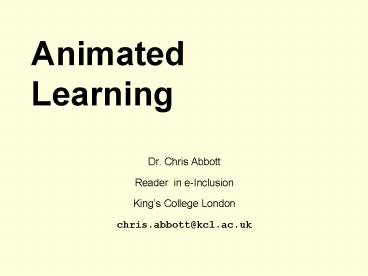Animated Learning - PowerPoint PPT Presentation
1 / 27
Title:
Animated Learning
Description:
Animated Learning Dr. Chris Abbott Reader in e-Inclusion King s College London chris.abbott_at_kcl.ac.uk Show first part of video to demonstrate how drawing and ... – PowerPoint PPT presentation
Number of Views:95
Avg rating:3.0/5.0
Title: Animated Learning
1
Animated Learning
- Dr. Chris Abbott
- Reader in e-Inclusion
- Kings College London
- chris.abbott_at_kcl.ac.uk
2
Animation a unique art form The Animated
Learning project Reading animation learning
outcomes Activity Genre knowledge Making
animation learning outcomes Some case studies
3
Animation a unique art form
The Saga of Biorn
4
Animation is a seductive and accessible medium
which has developed over more than one hundred
years. In the last thirty years, the
technologies of animation production have become
democratised, making them available to much
larger numbers of people, including students in
schools. ...and as such, this work is part of
the developing range of literacy practices
available to learners
5
Animation (even very simple animation) can help
us to access complex texts...
Ken Robinson on Changing Education Paradigms
6
One froggy evening (1955)
- 7 minutes
- the Citizen Kane of animated film (Spielberg)
- Uses mythic/folk tale motifs
- Time-shift to the future
- Repeating plot device
7
The animated learning project
8
Animated Learning (EU project)
Led by the VIA University College, Denmark an
international centre for the education of
animators Partners from other parts of Denmark
(Danish Pedagogical University, Viborg Commune)
as well as Estonia (Kinobuss) and UK (Kings
College London). Project runs from 2010 to 2011
but may be extended Series of publications
available from early 2012. Project details
9
Reading animationlearning outcomes
10
Reading animation
Leads to enhanced understanding of narrative
conventions and structure, as well as genre,
characterisation, media and language
11
And it has been suggested that, far from being an
instigator of violence, cartoon aggression may be
helpful in building the capacity to
discriminate (Hodge Tripp)
12
Activity genre knowledge
13
- What happened to Biorn?
- He got to Valhalla
- He ended up in Hallheim
- He didnt die.
- He ended up somewhere else.
14
Making animationlearning outcomes
Word steps (Denmark)
15
Enables those for whom text is challenging to
present complex stories using metaphor, genre
knowledge and allusion.
16
Contributes to moving image literacy and a model
of moving image grammar (Burn Parker)
17
Illuminates and reveals power discourses (Mills,
Australia) and builds process language through
animation as a group task
18
Can be seen as part of a process of semiotic
production discourse, design, production,
distribution (Kress van Leeuwen)
19
Storyboarding as a combination of writing and
visual design
Skabelsesberetningenbauneskole (Denmark)
20
The central role of editing (as with text)
21
Some case studies
22
Animation and autism
Can animation pedagogy support or even develop
social interaction? Can it help teachers
understand students with ASD Can students with
ASD communicate more effectively through
animation?
23
Animation and dyslexia
Ordblind (Denmark)
24
Animation and language diversity
Adding sound to an animated film as a literacy
event
25
Animation and disaffection/disadvantage
Nicholas Kallincos, Australia http//www.picnick.
com.au/
26
...there is a need to identify the nature of the
scaffolding and adult support children need as
they create multimodal, digital texts... The
creation of appropriate pedagogical and
curricular approaches can only occur through
detailed analyses of classroom projects which
trace the skills, knowledge and understanding
developed in media production. There is a large
body of work which outlines what is known about
young childrens print-based literacy skills...
There is now an urgent need to begin to map out
similar terrain in relation to multimodal
communicative practices... (Marsh)
27
References
Abbott, C. (1990). Children, animated film and
language learning. Unpublished MA, Institute of
Education, London. Burn, A., Parker, D. (2001).
Making your mark digital inscription, animation
and a new visual semiotic. Education,
Communication Information, 1(2), 155-179. Burn,
A., Parker, D. (2003a). Analysing Media Texts.
London Continuum. Burn, A., Parker, D.
(2003b). Tiger's Big Plan Multimodality and the
moving image. In G. Kress C. Jewitt (Eds.),
Multimodal Literacies. New York Peter
Lang. Burn, A., Durran, J. (2007). Media
Literacy in Schools Practice, Production and
Progression. London Paul Chapman
Publishing. Crook, C. (1994). Computers and the
collaborative experience of learning. London
Routledge. Frost, J. (1976). Conference paper,
International Association for the Child's Right
to Play. Birmingham. Hodge, B., Tripp, D.
(1986). Children and Television. Cambridge
Polity Press. Kress, G., Leeuwen, T. v. (1996).
Reading Images The Grammar of Visual Design.
London Routledge. Kress, G. Leeuwen, T. v.
(2001). Multimodal Discourses. London
Arnold. Lachs, V. (1999). The Moving Picture
Science Show working with multimedia in the
classroom. In J. Sefton-Green (Ed.), Young
People, Creativity and New Technologies The
Challenge of Digital Arts (pp. 12-21). London
Routledge. Loveless, A., Ellis, V. (Eds.).
(2001). ICT, Pedagogy and the Curriculum Subject
to Change. London RoutledgeFalmer. Madden, M.,
Chung, P. W. H., Dawson, C. W. (2008). The
effect of a computer-based cartooning tool on
childrens cartoons and written stories.
Computers Education, 51(2), 900-925. Marsh, J.
(2006). Emergent Media Literacy Digital
Animation in Early Childhood. Language and
Education, 20(6), 493-506. Mills, K. (2007).
"Have you seen Lord of the Rings?" Power,
Pedagogy, and Discourses in a Multiliteracies
Classroom. Journal of Language, Identity
Education, 6(3), 221-241. Thomas F., Johnston,
O. (1981) Disney Animation the Illusion of
Life. New York Abbeville Press Sefton-Green, J.,
Buckingham, D. (1998). Digital Visions
Children's 'Creative' Uses of Multimedia
Technologies. In J. Sefton-Green (Ed.), Digital
Diversions Youth Culture in the Age of
Multimedia (pp. 62-83). London UCL
Press. Yandell, J. (2004). Sermons in stones, or
how many kick-ups can you do? Changing English,
11(2), 175-182.































